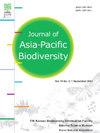The mitochondrial genome of a carnivorous lucanid, Figulus punctatus Waterhouse, 1873 (Coleoptera: Lucanidae)
IF 0.6
Q4 BIODIVERSITY CONSERVATION
引用次数: 0
Abstract
This study represents the first report of the complete mitochondrial genome of a carnivorous stag beetle, Figulus punctatus. The genome is 17,664 bp long with a total of 37 genes including 13 protein-coding genes, 22 tRNA, and 2 rRNA. The nucleotide composition is 37.25% A, 31.71% T, 10.00% G, and 20.99% C (GC contents 30.99%). Our molecular phylogenetic analysis based on the maximum-likelihood method recognizes Figulini and Nigidiini as a monophyletic clade, with a robust support value, and suggests that their carnivorous feeding trait may have evolved once within the family.
食肉晰蜴--Figulus punctatus Waterhouse, 1873(鞘翅目:晰蜴科)的线粒体基因组
本研究首次报道了食肉锹形虫(Figulus punctatus)的完整线粒体基因组。该基因组长 17,664 bp,共有 37 个基因,包括 13 个蛋白质编码基因、22 个 tRNA 和 2 个 rRNA。核苷酸组成为 37.25% A、31.71% T、10.00% G 和 20.99% C(GC 含量为 30.99%)。我们基于最大似然法进行的分子系统进化分析表明,Figulini 和 Nigidiini 是一个单系支系,支持度很高,这表明它们的肉食性食性可能是在科内进化而来的。
本文章由计算机程序翻译,如有差异,请以英文原文为准。
求助全文
约1分钟内获得全文
求助全文
来源期刊

Journal of Asia-Pacific Biodiversity
Agricultural and Biological Sciences-Insect Science
CiteScore
1.70
自引率
12.50%
发文量
94
审稿时长
27 days
期刊介绍:
The Journal of Asia-Pacific Biodiversity (previous title was Journal of Korean Nature) is an official journal of National Science Museum of Korea (NSMK) and Korea National Arboretum (KNA). The scope of journal is wide and multidisciplinary that publishes original research papers, review articles, as well as conceptual, technical and methodological papers on all aspects of biological diversity-its description, analysis and conservation, and its application by humankind. This wide and multidisciplinary journal aims to provide both scientists and practitioners in conservation theory, policy and management with comprehensive and applicable information. However, papers should not be submitted that deal with microorganisms, except in invited paper. Articles that are focused on the social and economical aspects of biodiversity will be normally not accepted.
 求助内容:
求助内容: 应助结果提醒方式:
应助结果提醒方式:


